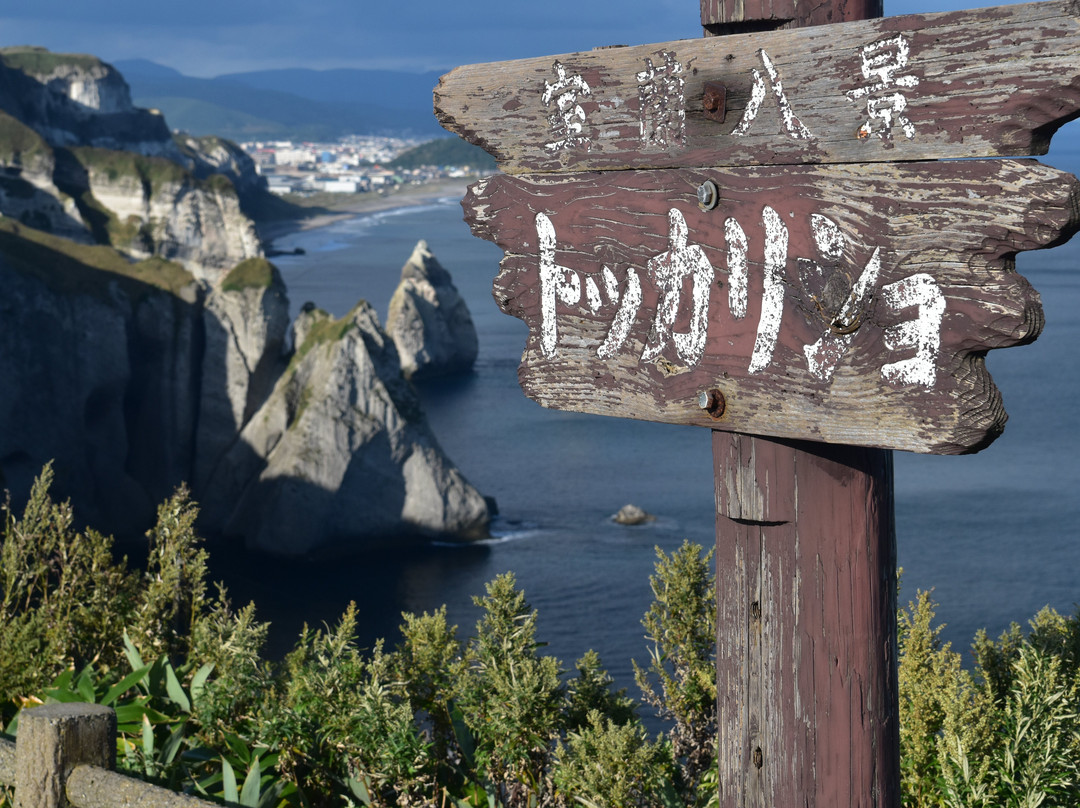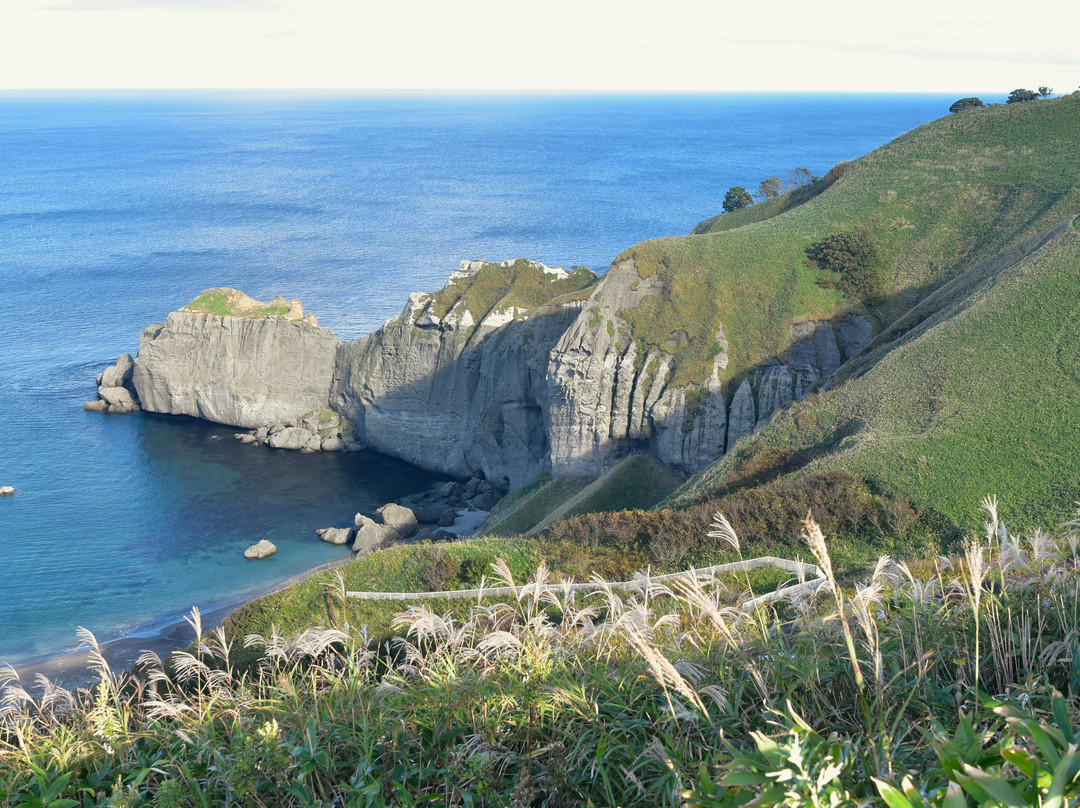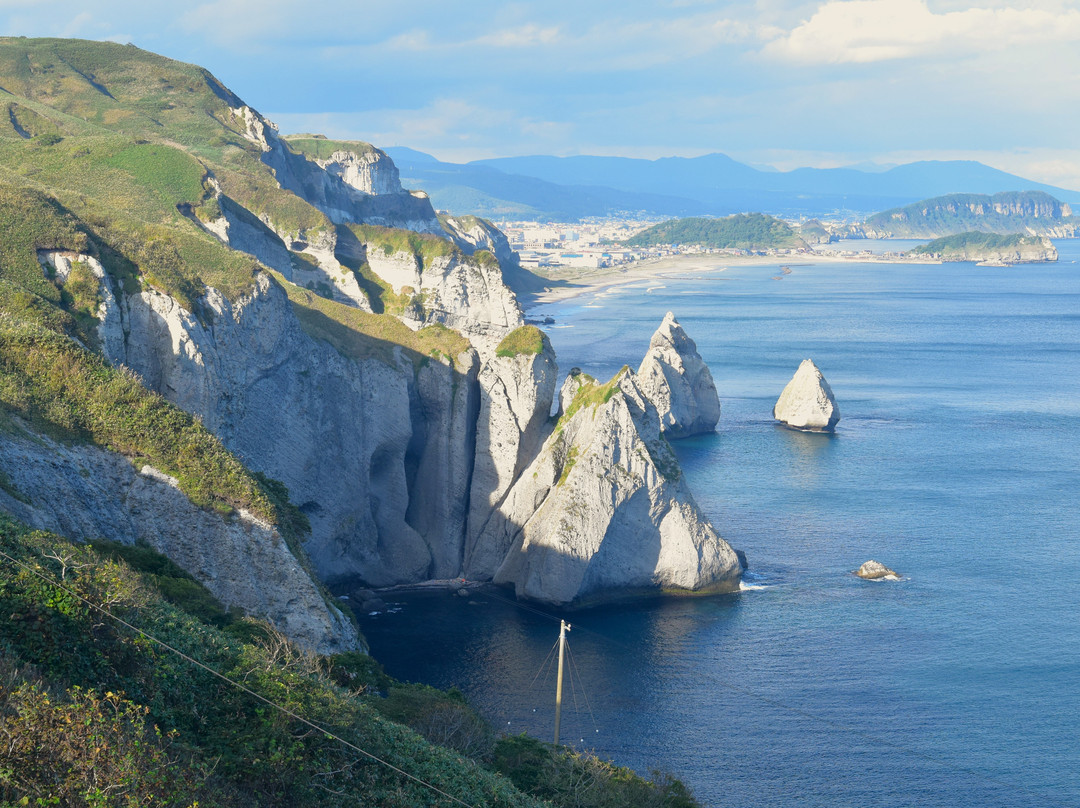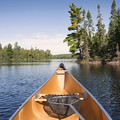的点评
Tokkarisho scenic area - a spectacular natural beauty hidden gem
Tokkarisho Lookout的点评
点评:In southwestern Hokkaido lies the port city of Muroran with its voted Muroran Hakkei (translated as “eight sights of Muroran”) that comprises (1) Tokkarisho scenic area (2) Kinbyobu (gold screen) and Ginbyobu (silver screen) cliffs (3) Cape Chikyu (4) view from Mount Sokuryo (Sokuryozan) lookout observatory (5) Masuichi Beach outer sea view (6) Daikokujima (Daikoku Island) (7) Cape Etomo (8) Muroran Harbour night view.
As part of my family’s 10-day Hokkaido self-drive itinerary, we did three of the eight sights of Muroran: Tokkarisho scenic area (トッカリショの奇勝 or Tokkarisho no kisho), Kinbyobu and Ginbyobu cliffs and Cape Chikyu. We started with Tokkarisho scenic area in which the Tokkarisho Lookout Observatory is the best place to see this scenic attraction. In the indigenous Ainu language, “tokaru isho” (from which “tokkarisho” comes from) means “seal rock”. It was believed that seals were present in this area in the past.
Getting there: We arrived at Tokkarisho Lookout Observatory (トッカリショ展望台) from Obihiro using Apple Maps and Google Maps on the Apple Car Play in our rental car. Tokkarisho Lookout Observatory is located along coastal highway 919 (中央東線) and can also be reached via car or taxi from JR Muroran Station in about 12 minutes and from JR Higashi Muroran Station in about 15 minutes. We looked for a wavy wooden signboard that states “室蘭八景トッカリショ“ (“Muroran Eight Sights Tokkarisho”) and then parked the car free-of-charge in front of the Lookout Observatory. The car parking area has no designated/painted parking lots and can accommodate about eight cars. I did not see any nearby bus stops or any public buses that come here.
The Lookout attraction: We spent a relaxing half an hour here on a sunny Saturday mid-afternoon. Even though it was a weekend afternoon, we were the only ones at the Lookout Observatory. It has no entrance fee and opens the whole day and night. When we alighted from the car and walked straight towards the observatory edge, we were simply amazed by the spectacular scenery in front of us – first the blue sky touching the dark blue (North) Pacific Ocean, then as the Pacific Ocean comes towards us, it meets the mainly columnar Cape Tokkarisho on the right, Tokkarisho Beach in the centre and on the left, the precipitous Tokkarisho Cliffs, pyramidal-shaped rocks in the sea (sources point to their formation as a result of tectonic uplift of a volcano), 1.7 kilometre Itanki Beach, Itanki Beach Whale Peninsula, Cape Washibetsu and the distant yet distinct mountain range in which Lake Kuttara and Mount Orofure (Orofureyama) are part of.
To me, the “stars” at the Lookout Observatory are firstly the Tokkarisho Cliffs towering mightily over 100 metres with vertical columnar structured formations and horizontal strata rock layers and secondly the “triple humped” Cape Tokkrisho in which the central “hump” resembled the head of an animal with flat eye and flat mouth (even the first “hump” furthest from the sea resembles the head of a dog). Both bamboo grass covered Tokkarisho Cliffs, Cape Tokkarisho and the pyramidal-shaped rocks are testament of the sculpturing work of Mother Nature of its natural beauty! Additionally, we saw the horizon that separates the Pacific Ocean and the sky is not indefinitely straight but curved – so the Earth is round and not flat. We spent our time taking lots of photos, selfies, wefies and videos on our handphones and zooming in on the Cape Tokkarisho and Tokkarisho Cliffs on my DSLR camera telephoto lens.
We saw a narrow road near the observatory deck that goes down toward Tokkarisho Beach but it is closed to the public. If you have time, you could walk about 300 metres along the road to the left of the Tokkarisho Lookout Observatory to a lookout spot known as Kameiwa (亀岩) where you could enjoy the view of the entire Tokkarisho Beach and the side of Cape Tokkarisho as well as a closer view of the precipitous Tokkarisho Cliffs wherein one of the rock formations resembles a turtle head when looking from a certain angle (be careful when you walk towards the edge).
Besides the spectacular rugged scenery, we also enjoyed the refreshment offered by the occasional gentle wind as well as the tranquility at the lookout observatory due to lack of visitors. There are no lavatories and shops, but there are two flat benches for you to relax and perhaps have a mini-picnic while soaking in the scenery. I hope the authorities could translate the information board at the lookout observatory in Japanese to English.
Tokkarisho Lookout Observatory is about 1.5 kilometre away (about 5 minutes’ drive) from another well-known attraction, Cape Chikyu. To me, the spectacular views from Tokkarisho Lookout Observatory can rival that of Cape Chikyu. Since Cape Chikyu is ranked number one in the “北海道の自然100選” or “Hokkaido Natural Beauty 100” list (published by Asahi Shimbun in 1985), hence I would definitely recommend the off-the-beaten-track Tokkarisho Lookout Observatory as a “must visit” when you are in Hokkaido. With its spectacular natural beauty landscape and seascape combined with relaxation and peace amidst Mother Nature’s wonders, this is truly a hidden gem! After all, it is voted as one of the eight sights of Muroran. Nevertheless, do check the weather before you come here because you will not see the spectacular landscape and seascape in heavy rain or fog. Finally, to have an all-round appreciation of the marvellous natural beauty of Tokkarisho Cliffs (and the remaining six of the “eight sights of Muroran” minus Muroran Harbour), I would recommend a cruise along the 14-kilometre coastline from April to November.
As part of my family’s 10-day Hokkaido self-drive itinerary, we did three of the eight sights of Muroran: Tokkarisho scenic area (トッカリショの奇勝 or Tokkarisho no kisho), Kinbyobu and Ginbyobu cliffs and Cape Chikyu. We started with Tokkarisho scenic area in which the Tokkarisho Lookout Observatory is the best place to see this scenic attraction. In the indigenous Ainu language, “tokaru isho” (from which “tokkarisho” comes from) means “seal rock”. It was believed that seals were present in this area in the past.
Getting there: We arrived at Tokkarisho Lookout Observatory (トッカリショ展望台) from Obihiro using Apple Maps and Google Maps on the Apple Car Play in our rental car. Tokkarisho Lookout Observatory is located along coastal highway 919 (中央東線) and can also be reached via car or taxi from JR Muroran Station in about 12 minutes and from JR Higashi Muroran Station in about 15 minutes. We looked for a wavy wooden signboard that states “室蘭八景トッカリショ“ (“Muroran Eight Sights Tokkarisho”) and then parked the car free-of-charge in front of the Lookout Observatory. The car parking area has no designated/painted parking lots and can accommodate about eight cars. I did not see any nearby bus stops or any public buses that come here.
The Lookout attraction: We spent a relaxing half an hour here on a sunny Saturday mid-afternoon. Even though it was a weekend afternoon, we were the only ones at the Lookout Observatory. It has no entrance fee and opens the whole day and night. When we alighted from the car and walked straight towards the observatory edge, we were simply amazed by the spectacular scenery in front of us – first the blue sky touching the dark blue (North) Pacific Ocean, then as the Pacific Ocean comes towards us, it meets the mainly columnar Cape Tokkarisho on the right, Tokkarisho Beach in the centre and on the left, the precipitous Tokkarisho Cliffs, pyramidal-shaped rocks in the sea (sources point to their formation as a result of tectonic uplift of a volcano), 1.7 kilometre Itanki Beach, Itanki Beach Whale Peninsula, Cape Washibetsu and the distant yet distinct mountain range in which Lake Kuttara and Mount Orofure (Orofureyama) are part of.
To me, the “stars” at the Lookout Observatory are firstly the Tokkarisho Cliffs towering mightily over 100 metres with vertical columnar structured formations and horizontal strata rock layers and secondly the “triple humped” Cape Tokkrisho in which the central “hump” resembled the head of an animal with flat eye and flat mouth (even the first “hump” furthest from the sea resembles the head of a dog). Both bamboo grass covered Tokkarisho Cliffs, Cape Tokkarisho and the pyramidal-shaped rocks are testament of the sculpturing work of Mother Nature of its natural beauty! Additionally, we saw the horizon that separates the Pacific Ocean and the sky is not indefinitely straight but curved – so the Earth is round and not flat. We spent our time taking lots of photos, selfies, wefies and videos on our handphones and zooming in on the Cape Tokkarisho and Tokkarisho Cliffs on my DSLR camera telephoto lens.
We saw a narrow road near the observatory deck that goes down toward Tokkarisho Beach but it is closed to the public. If you have time, you could walk about 300 metres along the road to the left of the Tokkarisho Lookout Observatory to a lookout spot known as Kameiwa (亀岩) where you could enjoy the view of the entire Tokkarisho Beach and the side of Cape Tokkarisho as well as a closer view of the precipitous Tokkarisho Cliffs wherein one of the rock formations resembles a turtle head when looking from a certain angle (be careful when you walk towards the edge).
Besides the spectacular rugged scenery, we also enjoyed the refreshment offered by the occasional gentle wind as well as the tranquility at the lookout observatory due to lack of visitors. There are no lavatories and shops, but there are two flat benches for you to relax and perhaps have a mini-picnic while soaking in the scenery. I hope the authorities could translate the information board at the lookout observatory in Japanese to English.
Tokkarisho Lookout Observatory is about 1.5 kilometre away (about 5 minutes’ drive) from another well-known attraction, Cape Chikyu. To me, the spectacular views from Tokkarisho Lookout Observatory can rival that of Cape Chikyu. Since Cape Chikyu is ranked number one in the “北海道の自然100選” or “Hokkaido Natural Beauty 100” list (published by Asahi Shimbun in 1985), hence I would definitely recommend the off-the-beaten-track Tokkarisho Lookout Observatory as a “must visit” when you are in Hokkaido. With its spectacular natural beauty landscape and seascape combined with relaxation and peace amidst Mother Nature’s wonders, this is truly a hidden gem! After all, it is voted as one of the eight sights of Muroran. Nevertheless, do check the weather before you come here because you will not see the spectacular landscape and seascape in heavy rain or fog. Finally, to have an all-round appreciation of the marvellous natural beauty of Tokkarisho Cliffs (and the remaining six of the “eight sights of Muroran” minus Muroran Harbour), I would recommend a cruise along the 14-kilometre coastline from April to November.
翻译:港口城市室兰位于北海道西南部,其被誉为“室兰八景”的景点包括:(1)特剎那所风景区(2)金屏风和银屏风悬崖(3)地球岬(4)从叠岭山瞭望台看到的景色(5)益市海滩外海景(6)大黑岛(7)惠鞆岬(8)室兰港夜景。
作为我家 10 天北海道自驾游行程的一部分,我们游览了室兰八景中的三个:特剎那所风景区(トッカリショの奇胜或 Tokkarisho no kisho)、金屏风和银屏风悬崖以及地球岬。我们从特卡里绍风景区开始,其中特卡里绍展望台是观赏这个风景名胜的最佳地点。在土著阿伊努语中,“tokaru isho”(“tokkarisho”的来源)的意思是“海豹岩”。人们认为过去海豹曾出现在这个地区。
到达方式:我们从带广出发,使用租车上的 Apple Car Play 上的 Apple Maps 和 Google Maps 到达特卡里绍展望台。特卡里绍展望台位于沿海公路 919(中央东线)沿线,从 JR 室兰站乘汽车或出租车约 12 分钟即可到达,从 JR 东室兰站乘汽车或出租车约 15 分钟即可到达。我们找到一块写着“室蘭八景トッカリショ”(“室蘭八景トッカリショ”)的波浪形木牌,然后把车免费停在瞭望台前。停车场没有指定/涂漆的停车场,可容纳约八辆车。我没有看到附近有任何巴士站或任何来这里的公共巴士。
瞭望台景点:我们在一个阳光明媚的周六下午在这里度过了轻松的半个小时。尽管是周末下午,但瞭望台上只有我们。它不收取入场费,全天开放。下了车,径直走向瞭望台边缘,眼前的美景让我们惊叹不已——首先是蔚蓝的天空与深蓝色的(北)太平洋相接,然后太平洋向我们涌来,右侧是主要呈柱状的特卡里绍岬,中间和左侧是特卡里绍海滩,陡峭的特卡里绍悬崖,海中的金字塔形岩石(据资料显示,它们是由火山构造隆起形成的),1.7公里长的伊丹喜海滩,伊丹喜海滩鲸鱼半岛,鹫别岬,以及遥远而独特的山脉,俱多乐湖和约罗弗山就位于山脉之中。
对我来说,瞭望台的“明星”首先是高达 100 多米的 Tokkarisho 悬崖,其上有垂直的柱状结构和水平的地层岩层,其次是“三峰”的 Tokkrisho 岬,中央的“驼峰”像动物的头,眼睛扁平,嘴巴扁平(甚至离海最远的第一个“驼峰”也像狗的头)。竹草覆盖的 Tokkarisho 悬崖、Tokkarisho 岬和金字塔形的岩石都是大自然雕刻的自然美景的见证!此外,我们看到太平洋和天空之间的地平线不是无限笔直的,而是弯曲的——所以地球是圆的,不是平的。我们花了很多时间用手机拍了很多照片、自拍、合影和视频,并用我的数码单反相机长焦镜头放大 Tokkarisho 岬和 Tokkarisho 悬崖。
我们在观景台附近看到了一条通往 Tokkarisho 海滩的狭窄道路,但这条路不对公众开放。如果你有时间,你可以沿着 Tokkarisho 瞭望台左侧的道路步行约 300 米,到达一个被称为 Kameiwa (亀岩) 的观景台,在那里你可以欣赏整个 Tokkarisho 海滩和 Tokkarisho 岬一侧的景色,以及近距离欣赏陡峭的 Tokkarisho 悬崖,从某个角度看,其中一块岩石类似于乌龟头(当你走向边缘时要小心)。
除了壮观的崎岖景色外,我们还享受了偶尔吹来的微风带来的清爽,以及由于游客稀少而导致的观景台的宁静。这里没有厕所和商店,但有两个平凳供您放松,也许还可以在欣赏风景的同时享受一次小型野餐。我希望当局能将瞭望台的信息板从日语翻译成英语。
德卡里绍瞭望台距离另一个著名景点地球岬约 1.5 公里(约 5 分钟车程)。对我来说,德卡里绍瞭望台的壮丽景色可以与地球岬相媲美。由于地球岬在“北海道の自然100選”或“北海道自然美景 100”榜单(由朝日新闻于 1985 年出版)中排名第一,因此,我强烈推荐人迹罕至的德剎那瞭望台,将其作为北海道“必游之地”。这里拥有壮观的自然美景和海景,再加上大自然奇观中的放松与平和,真是一颗隐藏的宝石!毕竟,它被评为室兰八景之一。不过,来之前一定要查看天气,因为大雨或大雾天气下,您将看不到壮观的景观和海景。最后,为了全面欣赏德剎那悬崖(以及室兰八景中除室兰港以外的其余六个)的奇妙自然美景,我建议您在 4 月到 11 月期间沿着 14 公里长的海岸线乘船游览。
作为我家 10 天北海道自驾游行程的一部分,我们游览了室兰八景中的三个:特剎那所风景区(トッカリショの奇胜或 Tokkarisho no kisho)、金屏风和银屏风悬崖以及地球岬。我们从特卡里绍风景区开始,其中特卡里绍展望台是观赏这个风景名胜的最佳地点。在土著阿伊努语中,“tokaru isho”(“tokkarisho”的来源)的意思是“海豹岩”。人们认为过去海豹曾出现在这个地区。
到达方式:我们从带广出发,使用租车上的 Apple Car Play 上的 Apple Maps 和 Google Maps 到达特卡里绍展望台。特卡里绍展望台位于沿海公路 919(中央东线)沿线,从 JR 室兰站乘汽车或出租车约 12 分钟即可到达,从 JR 东室兰站乘汽车或出租车约 15 分钟即可到达。我们找到一块写着“室蘭八景トッカリショ”(“室蘭八景トッカリショ”)的波浪形木牌,然后把车免费停在瞭望台前。停车场没有指定/涂漆的停车场,可容纳约八辆车。我没有看到附近有任何巴士站或任何来这里的公共巴士。
瞭望台景点:我们在一个阳光明媚的周六下午在这里度过了轻松的半个小时。尽管是周末下午,但瞭望台上只有我们。它不收取入场费,全天开放。下了车,径直走向瞭望台边缘,眼前的美景让我们惊叹不已——首先是蔚蓝的天空与深蓝色的(北)太平洋相接,然后太平洋向我们涌来,右侧是主要呈柱状的特卡里绍岬,中间和左侧是特卡里绍海滩,陡峭的特卡里绍悬崖,海中的金字塔形岩石(据资料显示,它们是由火山构造隆起形成的),1.7公里长的伊丹喜海滩,伊丹喜海滩鲸鱼半岛,鹫别岬,以及遥远而独特的山脉,俱多乐湖和约罗弗山就位于山脉之中。
对我来说,瞭望台的“明星”首先是高达 100 多米的 Tokkarisho 悬崖,其上有垂直的柱状结构和水平的地层岩层,其次是“三峰”的 Tokkrisho 岬,中央的“驼峰”像动物的头,眼睛扁平,嘴巴扁平(甚至离海最远的第一个“驼峰”也像狗的头)。竹草覆盖的 Tokkarisho 悬崖、Tokkarisho 岬和金字塔形的岩石都是大自然雕刻的自然美景的见证!此外,我们看到太平洋和天空之间的地平线不是无限笔直的,而是弯曲的——所以地球是圆的,不是平的。我们花了很多时间用手机拍了很多照片、自拍、合影和视频,并用我的数码单反相机长焦镜头放大 Tokkarisho 岬和 Tokkarisho 悬崖。
我们在观景台附近看到了一条通往 Tokkarisho 海滩的狭窄道路,但这条路不对公众开放。如果你有时间,你可以沿着 Tokkarisho 瞭望台左侧的道路步行约 300 米,到达一个被称为 Kameiwa (亀岩) 的观景台,在那里你可以欣赏整个 Tokkarisho 海滩和 Tokkarisho 岬一侧的景色,以及近距离欣赏陡峭的 Tokkarisho 悬崖,从某个角度看,其中一块岩石类似于乌龟头(当你走向边缘时要小心)。
除了壮观的崎岖景色外,我们还享受了偶尔吹来的微风带来的清爽,以及由于游客稀少而导致的观景台的宁静。这里没有厕所和商店,但有两个平凳供您放松,也许还可以在欣赏风景的同时享受一次小型野餐。我希望当局能将瞭望台的信息板从日语翻译成英语。
德卡里绍瞭望台距离另一个著名景点地球岬约 1.5 公里(约 5 分钟车程)。对我来说,德卡里绍瞭望台的壮丽景色可以与地球岬相媲美。由于地球岬在“北海道の自然100選”或“北海道自然美景 100”榜单(由朝日新闻于 1985 年出版)中排名第一,因此,我强烈推荐人迹罕至的德剎那瞭望台,将其作为北海道“必游之地”。这里拥有壮观的自然美景和海景,再加上大自然奇观中的放松与平和,真是一颗隐藏的宝石!毕竟,它被评为室兰八景之一。不过,来之前一定要查看天气,因为大雨或大雾天气下,您将看不到壮观的景观和海景。最后,为了全面欣赏德剎那悬崖(以及室兰八景中除室兰港以外的其余六个)的奇妙自然美景,我建议您在 4 月到 11 月期间沿着 14 公里长的海岸线乘船游览。



此点评仅代表旅行者个人的主观意见,并不代表TripAdvisor以及其合作方的意见。
关于我们
|
新闻动态
|
商务合作
|
会员中心
|
业主中心
|
业主通
|
常见问题
|
意见反馈
|
联系我们
|
营业执照
© 2025 Tripadvisor 版权所有。
使用条款 |隐私政策 |网站工作原理
部分照片由 VFM Leonardo 提供。
* Tripadvisor不是旅行社,也不是旅游预订服务代理商。我们提供免费、客观、公正的旅游资讯服务。 (显示更多)
TripAdvisor LLC 既不是预订代理商,也不是旅游运营商,不会向网站用户收取任何服务费。 按照规定,在 Tripadvisor 发布机票价格、游览和旅行套餐的合作伙伴(航空公司、旅行提供商及预订代理商),其标价须包含所有费用和附加费用。 例如, 机场出入境税费、消费税与其他服务费、手续费、杂费及附加费用。 当您向我们的某个合作伙伴进行预订时,请务必查阅他们的网站以了解当地行政部门要求的所有适用费用的具体情况。 除非另有说明,机票价格通常指的是一个人的价格(以人民币计)。
为方便起见,TripAdvisor LLC 根据从我们的预订合作伙伴获取的空房率计算每个酒店的均价。 对于游览和景点来说,所显示价格通常是每位成人的最低可用价格。 对于列出的任何旅行套餐或优惠,TripAdvisor LLC 无法保证任何特定的费率或价格。 此外,酒店均价每晚会更新,并以您的首选币种表示(使用现行汇率)。 由于这些已换算的价格是预估价格,因此,有关具体金额和币种请与预订网站进行核实。
此外,TripAdvisor LLC 无法保证我们网站上宣传的价格随时有效。 标价可能需要预订一定天数才能生效,或有不可用日期、使用条件或限制。
TripAdvisor公司对外部网站的内容一概不负责。优惠价格中不含税和其他费用。
ICP证:沪B2-20200433
沪ICP备20013175号
 沪公网安备31010502005427号
沪公网安备31010502005427号鹰程信息技术(上海)有限公司
货币/国家及地区
¥CNY
中国

